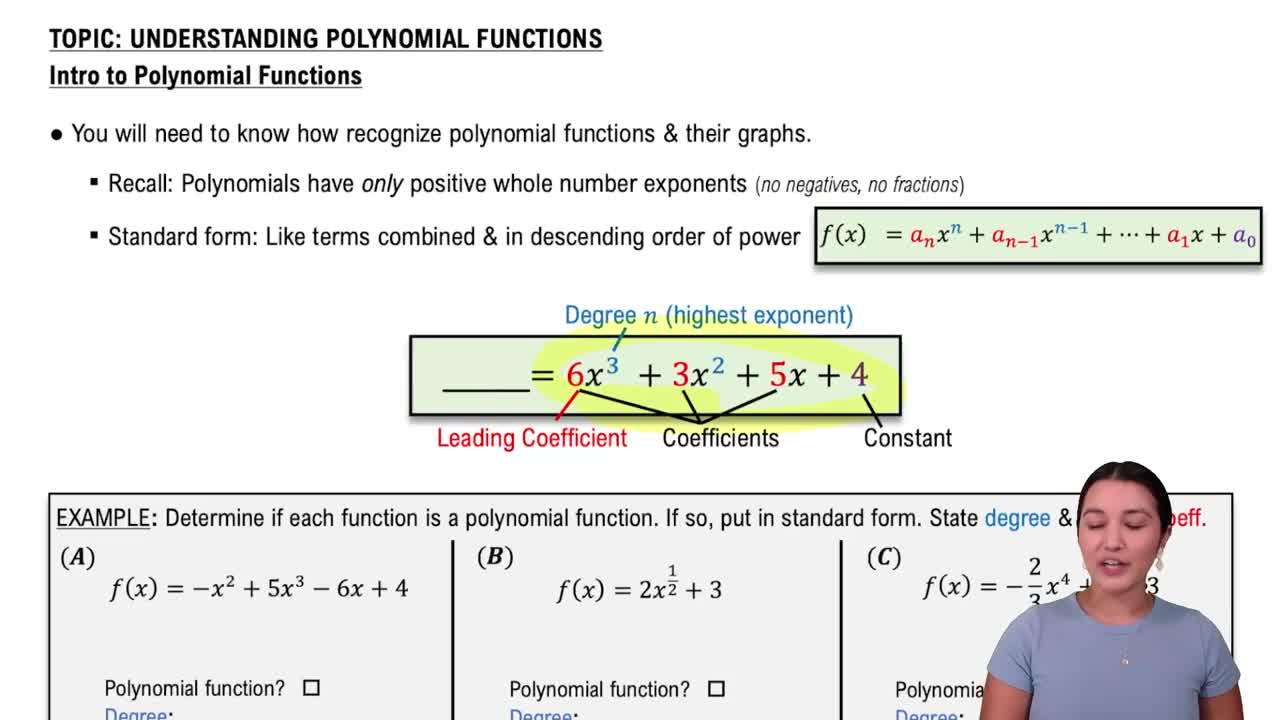Table of contents
- 0. Review of Algebra4h 16m
- 1. Equations & Inequalities3h 18m
- 2. Graphs of Equations43m
- 3. Functions2h 17m
- 4. Polynomial Functions1h 44m
- 5. Rational Functions1h 23m
- 6. Exponential & Logarithmic Functions2h 28m
- 7. Systems of Equations & Matrices4h 6m
- 8. Conic Sections2h 23m
- 9. Sequences, Series, & Induction1h 19m
- 10. Combinatorics & Probability1h 45m
4. Polynomial Functions
Graphing Polynomial Functions
Problem 39Blitzer - 8th Edition
Textbook Question
In Exercises 33–40, use the Intermediate Value Theorem to show that each polynomial has a real zero between the given integers. f(x)=3x^3−10x+9; between -3 and -2
 Verified step by step guidance
Verified step by step guidance1
Identify the function:
Evaluate the function at the first integer: Calculate
Evaluate the function at the second integer: Calculate
Check the sign of
Apply the Intermediate Value Theorem: Since
Recommended similar problem, with video answer:
 Verified Solution
Verified SolutionThis video solution was recommended by our tutors as helpful for the problem above
Video duration:
4mPlay a video:
Was this helpful?
Key Concepts
Here are the essential concepts you must grasp in order to answer the question correctly.
Intermediate Value Theorem
The Intermediate Value Theorem states that if a function is continuous on a closed interval [a, b] and takes on different signs at the endpoints, then there exists at least one c in (a, b) such that f(c) = 0. This theorem is crucial for proving the existence of real zeros in polynomial functions.
Recommended video:

Introduction to Hyperbolas
Polynomial Functions
A polynomial function is a mathematical expression involving a sum of powers in one or more variables multiplied by coefficients. In this case, f(x) = 3x^3 - 10x + 9 is a cubic polynomial, which is continuous and differentiable everywhere, making it suitable for applying the Intermediate Value Theorem.
Recommended video:

Introduction to Polynomial Functions
Sign Change
A sign change occurs when the value of a function changes from positive to negative or vice versa. To apply the Intermediate Value Theorem, we evaluate the polynomial at the endpoints of the interval, -3 and -2, to check for a sign change, indicating the presence of at least one real zero within that interval.
Recommended video:

Change of Base Property

 5:01m
5:01mWatch next
Master Identifying Intervals of Unknown Behavior with a bite sized video explanation from Callie
Start learningRelated Videos
Related Practice
Textbook Question
Graph each function. Determine the largest open intervals of the domain over which each function is (a) increasing or (b) decreasing. See Example 1. ƒ(x)=2x^4
228
views
